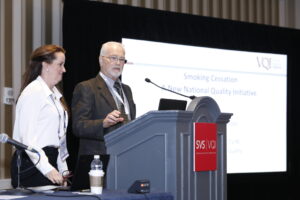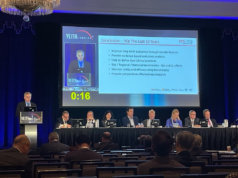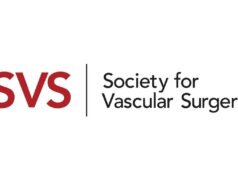
The SVS Patient Safety Organization (SVS PSO) has launched a national smoking cessation initiative.
SVS PSO Associate Medical Director Gary Lemmon, MD, and SVS PSO Director of Quality Betsy Wymer introduced the program during SVS PSO’s Vascular Quality Initiative’s (VQI) Annual Meeting Wednesday.
CAN-DO (Choosing Against Combustible Nicotine Despite Obstacles) joins two existing national initiatives on discharge medications and sac diameter reporting, with imaging, in connection with endovascular aneurysm repair (EVAR).
“Smoking is the leading cause of preventable death and disability, 10 times more than the premature deaths from all wars fought by the U.S,” said Lemmon. It’s a major cause of cardiovascular disease and more than 90% of cancer of the lungs and other organs. Moreover, secondhand smoke increases the risk of death and disability to those who do not smoke themselves.
CAN-DO includes three components to increase smoking quit rates: including smoking cessation variables (preop smoking in elective procedures only, and smoking cessative for elective, urgent and emergent cases) in VQI’s arterial registries; physician and patient toolkits; and revising the smoking cessation section on the SVS website, to make it more patient-centered and increase its visibility.
VQI currently captures some variables, but the new initiative expands upon them to include smoking status, history and demographics prior to surgery and in post-op care and long-term follow-up. Simplicity is stressed. “We’re trying to minimize the burden” on VQI members in terms of the additional variables, Wymer said.
The physician toolkit includes many elements physicians and surgeons will find useful, including results and efficacy from a clinical trial of a brief smoking cessation intervention, a “visual dictionary” on electronic cigarettes and vaping products, an educational library of useful resource documents, the patient-facing document housed on the SVS site and, importantly in a billable world, billable smoking cessation codes.
“We can receive reimbursement for talking to patients about quitting smoking,” said Lemmon. He discussed key phrases and elements to be included to meet the threshold for reimbursement.
The patient toolkit, meanwhile, includes links to many resources on quitting smoking.
Patient education is another important component, said Wymer. In the U.S., 30.8 million adults smoke cigarettes, 3.08 million middle and high school students use tobacco products, one in four people who don’t smoke are exposed to second-hand smoke and more than $240 billion a year goes to treat smoking-related diseases.
Moreover, tobacco companies target specific populations, including people of lower income, and spend $9.1 billion in marketing annually in the U.S. “There are nearly five times more tobacco retailers per square mile in neighborhoods with the lowest income compared to neighborhoods with the highest income,” she said.
Lemmon also noted that simply asking a patient, “Do you smoke?” is insufficient. Surgeons and doctors should instead extend the conversation to the “3 As”: ask if the patient wants to quit and when the patient smokes that first cigarette of the day; assist by offering liberal use of nicotine replacement therapy and medications but also add that the patient should not combine e-cigarettes as a crutch while also smoking; and give advice by referring patients to professional counseling, apps and other tools.
Other useful information includes a quick guide to treatment options, including nicotine patches, lozenges, nasal spray, gum and inhaler, and the use of counseling via text messaging, smartphone apps and web-based services.
Wymer and Lemmon also stressed the deleterious effects of smoking on health: increased risk for peripheral artery disease, plaque building in arteries. Smoking narrows, and thus damages, blood vessel walls, it increases blood pressure and heart rate; affects cholesterol and increases triglyceride levels, a type of fat found in the blood. Both SVS and the American Heart Association advice patients to quit smoking before surgery.
Learn more at www.vqi.org/smoking-cessation.












